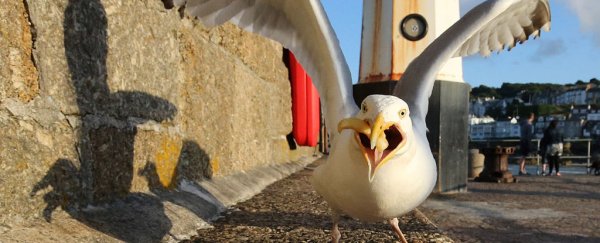Seagulls have an eye for good food, and while beggars can't be choosers, all things being equal, they're more interested in that tasty morsel you're clutching than a scrap of food simply lying on the ground.
New research in the United Kingdom suggests herring gulls (Larus argentatus) tend to go for edibles already handled by humans, and that's perhaps why this species has flourished so well in cities.
Gulls are notoriously adaptable and opportunistic birds that are often found flooding picnics in public parks. Today, many of these wild creatures live closely alongside humans, an overlooked shadow that hungrily eats up any and all crumbs left behind.
"UK herring gull numbers are declining, but urban populations have increased," says zoologist Madeleine Goumas from the University of Exeter.
"Despite the fact they're a common sight in many towns, little is known about urban gull behaviour."
Or, for that matter, how these birds interact with humans. Previous research by Goumas and her colleagues found gulls can definitely read human cues and can be warded off from a picnic table simply by creating eye contact.
While domestic pets like dogs have been shown to take similar signals from humans, this sort of thing is relatively undocumented in wild animals.
Now, researchers have found even more evidence that foraging gulls looking for food in cities take regular cues from their human neighbours.
The research involved finding and approaching dozens of gulls with two buckets of food, placed evenly in front of them. Each one of these buckets was then lifted up simultaneously to reveal a wrapped flapjack underneath, almost as if they were being served at a fancy dinner.
The human involved, who was wearing sunglasses to avoid eye contact, then picked up one of the flapjacks, handling it for 20 seconds before putting it back on the ground.
Of the 38 gulls tested, 24 of them pecked at one of the flapjacks and nearly 80 percent chose the one that had been fingered by the human. Quick to take advantage of the moment, these birds generally took less than a minute to approach the food.
"This shows that human handling of food attracts the attention of gulls and that handled food is more attractive than food that gulls have not observed being handled," the authors write.
This sort of behaviour implies a form of social learning known as "local enhancement", and it appears that gulls rely extensively on it, taking cues not only from other birds, but also from humans.
Having this additional source of information, the authors argue, is probably what has allowed these birds to survive so well in urban environments.
To see if humans alone are enough to attract gulls to an item, the team repeated the same experiment again, except this time they used two round sponges instead of flapjacks.
The gulls were not so easily fooled. Despite similar numbers approaching the sponges and the flapjacks, more of the birds approached the sponges without pecking at them.
"This suggests that gulls may approach objects before distinguishing what they are, and discriminate between types of object at a closer distance," the authors explain.
"It is improbable that the gulls had previously encountered the exact food and non-food objects we presented, and it is likely that they were initially attracted to both types of object to determine whether they contained or were composed of food."
Of course, some of the gulls did go check out the flapjack not handled by humans, but this didn't necessarily mean they ignored the signals.
It's conceivable, for instance, that the experimenter's presence alone was enough to intrigue these birds, drawing their attention to both the non-handled and the handled object equally.
Besides, their levels of perception might even be keen enough to discern both flapjacks were inherently the same, meaning it didn't matter which they approached.
Or perhaps this curiosity is not based on human behaviour at all. It's possible, the authors admit, that the gulls could also be attracted to the packaging of the food or its general appearance.
Clearly, there's still plenty of research to be done, and if we want to learn more about how human behaviour influences wild animals, these relatively outgoing and fearless gulls are an easy place to start.
The study was published in the Royal Society Open Science.
